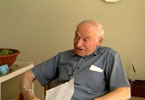|
During the 1920s and 1930s, there were some forty Jewish families living in the Beach. They tended to be more financially stable compared to their counterparts downtown. In turn, many of these residents had immigrated to Canada at an early age and spoke English as their first language. Several of the families owned businesses downtown and retained memberships with the downtown shuls.
The Beach district, particularly the boardwalk, was viewed as somewhat inhospitable to Jews during the 1920s and 1930s. Certain resorts and sports clubs, in fact, barred Jews from joining. One resort posted a sign reading “No Jews and No Dogs.” In addition, the Beach became a popular venue for pro-Nazi rallies during Hitler’s rise to power. Under the banner of the “Swastika Club,” some young Beach residents held several anti-Semitic marches along the boardwalk.
Despite these bouts of anti-Semitism, most of the Jewish families in the Beach lived very peaceably with their neighbours. Their children made friends at public school and played with the non-Jewish kids on their street. They attended community dance classes and participated in sports. For example, Ben Orenstein, who was a young boy at the time, remembered some of his friends knocking on his door to ask him to join their demonstration against the Jews; when he indicated to them that he himself was Jewish, they replied that it was different – he was part of the neighbourhood. For the most part, as Avrum Siegel recalls, the Jewish families at the Beach led productive and satisfying lives and got along well with their non-Jewish neighbours.
The synagogue played a central role in helping Jewish residents of that area feel a sense of community. It was founded in early October 1919, when the Jewish residents of the Beach held a meeting to discuss starting a neighbourhood synagogue. The founders included Maurice and Tillie Wolfe, Louis and Elizabeth Schwartz, Hillel and Edith Wineberg, Manuel and Rose Gebertig, Hyman and Sarah Mehr as well as the Siegel’s and the Pritzker’s. This group, along with other individuals, immediately donated almost $1500 towards the purchase of a building or the construction of a new one. In all, 26 families supported this venture. They did not have to look far; a small, vacant building, formerly used as a church, was located right near Kew Gardens in the heart of the Beach. With the money the congregation had donated, along with two mortgages totaling $4500, the group made an offer on the property at 109 Kenilworth Avenue on the 25th of October. Nine days later, the congregation had a home. They called it Beth Jacob in Hebrew and the Beach Hebrew Institute in English. Due to the lack of Jews in the area, as well as the anti-Semitic atmosphere at some points, the congregation tended to rely on the English name for the shul.
The congregation was quite active during the 1920s and 1930s, running regular and holiday services, afternoon Hebrew classes for the children, and a Sunday school. It was always filled to capacity during the High Holidays. In 1926, the synagogue was renovated in order to create more space for its activities; it received a new front façade and an extended upstairs gallery for the religious school. The shul continued to be well attended until the years immediately preceding, and during, the Second World War. At this time, a large number of congregants left the Beach area and moved north-west, to neighbourhoods around St. Clair Avenue, such as Forest Hill and Cedarvale. With this outflow of members, the synagogue became quite strained financially. Eventually, the Beach Sisterhood disbanded and the synagogue was forced to cancel its Hebrew and Sunday schools. After two decades of vibrant Jewish life in the Beach, the synagogue encountered its first years of difficulty. continued to be well attended until the years immediately preceding, and during, the Second World War. At this time, a large number of congregants left the Beach area and moved north-west, to neighbourhoods around St. Clair Avenue, such as Forest Hill and Cedarvale. With this outflow of members, the synagogue became quite strained financially. Eventually, the Beach Sisterhood disbanded and the synagogue was forced to cancel its Hebrew and Sunday schools. After two decades of vibrant Jewish life in the Beach, the synagogue encountered its first years of difficulty.
During the late 1940s and early 1950s, a new group of Jewish families moved to the Beach and brought new life to the synagogue. They re-established the Sisterhood and formed a Brotherhood, which together cleaned up and repaired the synagogue, hosted successful social events, rummage sales, teas, and children’s parties. Once again, the religious school was resurected and enrollment in Sunday school became so high that they had to hold classes in the basement, to accommodate all of the students.
Unfortunately, this second wave of Jewish life in the Beach didn’t last long. Toronto’s Jewish population had spread northwards along Bathurst Street, and during the 1960s, more and more of the Beach’s Jewish families moved there to be closer to the major Jewish schools, organizations and community centres. The synagogue struggled to maintain its programs, but by the end of the decade, was again only able to offer High Holiday services. With little sign of the Jewish population returning, those who remained in the Beach area struggled against increasing pressure to sell the building. Yet they resisted, with the hope that a new generation of Jews would once again make the Beach their home.
NEXT  |
|

The Harris and Cohen families at Herschelle Cottage at Kew Beach, 1919.

Cornerstones, c.1927.

Cornerstones, c.1927.

Kenilworth Avenue Baptist Church and Parsonage, c.1908

By-laws of the Beach Hebrew Institute, 1925.

Statutory Declaration of Hyman Mehr, 1926.

Video Clip: Avrom Siegel discusses growing up Jewish in a non-Jewish area, 2006

Synagogue founders Asher Pritzker (middle) and Joseph Marin (right), c.1936

Founder Maurice Wolfe (left) with his brother Max inside the Toronto Wholesale Fruit Market, 1960.
|